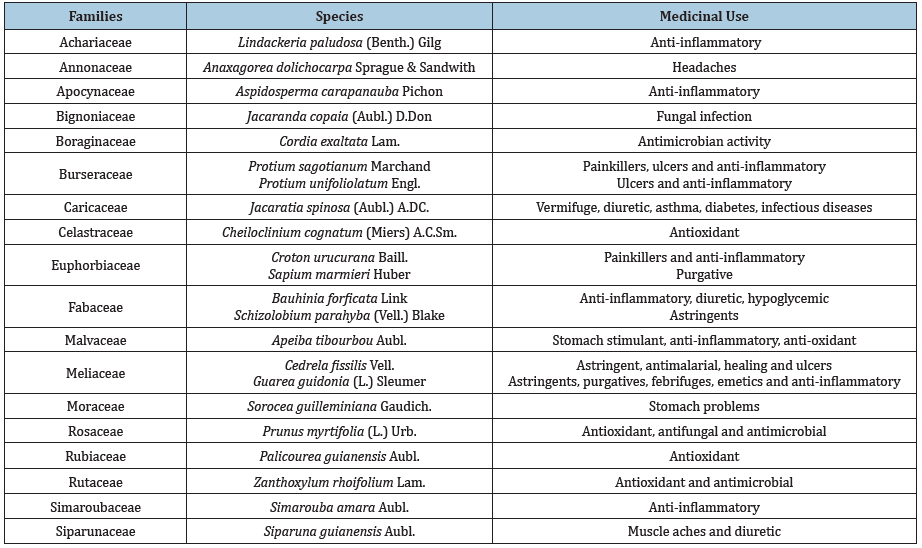- Submissions

Full Text
Biodiversity Online J
Native Trees from Amazon Forest Fragments with Medicinal Potential
Aline Gonçalves Spletozer*
Department of Forestry, University in Viçosa, Brazil
*Corresponding author: Aline Gonçalves Spletozer, Department of Forestry, University in Viçosa, Brazil
Submission: November 03, 2020; Published: November 30, 2020

Volume1 Issue2November, 2020
Abstract
The impacts on the Amazonian flora bring a significant reduction of plant species considered medicinal, even before being studied. In this mini review we show several medicinal tree species from forest remnants in the Amazon.Of the 60 species recorded in the two fragments, 22 showed medicinal use registered in the literature. The greatest use found was anti-inflammatory, followed by antioxidant and ulcer. The results show that the tree species occurring in the studied fragments have wide medicinal use, being, therefore, a possible source of extraction of compounds for pharmacological use. Evidencing the importance of the conservation of these habitats for the preservation of the flora and for the health.
Keywords: Amazonian flora; Livestock; Antimicrobial; Antioxidant
Introduction
The loss and fragmentation of forest habitats is one of the most important and invasive consequences of the current dynamics of land use. The change generated by agriculture, livestock and urbanization is responsible for major changes in natural landscapes in all biomes, transforming continuous areas into isolated fragments, threatening the integrity of ecosystems [1]. All these impacts on flora bring a significant reduction of plant species considered medicinal, even before being studied [2].
Establishing species of medicinal plants as a target for research, defining their potential and use, becomes a means of conserving the remaining resources. [3] emphasize that the knowledge of the diversity of tree species is an important instrument for the screening of botanical material in analyzes of potential use, especially for pharmacological evaluation. A little explored theme in forest remnants, which allows the sustainable use of natural resources contained in these environments and can generate proposals for public policies that regulate the reduction of these areas, due to the importance of species that can be used medicinally by the population. Therefore, in this mini review we show several medicinal tree species from forest remnants in the Amazon. Studies like this are essential, both for the subsistence of fragments and protection of natural resources, as well as for the development of safe and rational use of these plants to treat basic health needs.
Trees with Medicinal Potential
From a list of species occurring in two forest fragments located in the south of the Amazon, with vegetation characterized as Dense Ombrophylous Forest, the medicinal use registered for these species was researched [4]. Of the 60 species recorded in the two fragments, 22 showed medicinal use registered in the literature (Table 1). The greatest use found was antiinflammatory, cited for about 37% of the species (8 species), followed by antioxidant and ulcer use and other stomach problems with 5 registered species. Three species were also found with diuretic use and three with antimicrobial use. Lindackeria paludosa (Benth.) Gilg presented indication against primary tumors, already Cedrela fissilis Vell is indicated as antimalarial [5,6].
Among the researched species Bauhinia forficata Link and Jacaratia spinosa (Aubl.) A.DC. presented with hypoglycemic and diabetes properties, respectively [7-9] mention several species used in Brazilian popular medicine, similar to the review presented by the present study, highlighting the importance of a study like this to enhance information on the uses of the native flora.
Table 1: Species present in forest fragments in the Amazon with medicinal uses mentioned in the literature.

Conclusion
The results show that the tree species occurring in the studied fragments have wide medicinal use, being, therefore, a possible source of extraction of compounds for pharmacological use. Evidencing the importance of the conservation of these habitats for the preservation of the flora and for the health.
References
- Tabarelli M, Gascon C (2005) Lessons from fragmentation research: Aperoutlining policies and guidelines for management for the repairvation of biodiversity. Megadiversity 1(1): 181-188.
- Alves EO, Mota JH, Soares TS, Vieira MDC, Silva CBD (2005) Etnobotanical survey and medicinal plants characterization in forest fragments in Dourados-MS. Science and Agrotechnology 32(2): 651-658.
- Chaves CL, Manfredi CS (2010) Medicinal trees from riparian forests along canoas river: Potential use in restoration projects. Brazilian Journal of Medicinal Plants 12(3): 322-332.
- IBGE (2012) Série manuais técnicos em geociê Manual Técnico da Vegetação Brasileira 1: 1-92.
- Fazio AL, Ballén D, Cesari IM, Abad MJ, Arsenak M, et al. (2010) Antitumour and anti-inflammatory activities in a hydroethanolic extract of Lindackeria paludosa, a south american shrub. Boletín Latinoamericano y del Caribe de Plantas Medicinales y Aromáticas 9(2): 143-150.
- Lorenzi H, Matos FJA (2008) Medicinal plants in brazil: Native and exotic. Plantarum Institute pp. 371.
- Pizzolatti MG, Cunha JA, Szpoganicz B, Sousa E, Braz Filho R, et al. (2003) Flavonoids glycosides from leaves and flowers of Bauhinia forficata (Leguminosae). New Chemistry 26(4): 466-469.
- Bratti C, Vieira MC, Zárate NAH, Oliveira APA, Marafiga BG, et al. (2013) Survey of medicinal plants native to fazenda azulão in Dourados-MS. Rev Bras Med Plants 15(4): 675-683.
- Fenner R, Betti AH, Mentz LA, Rates SMK (2006) Plants used in brazilian popular medicine with potential antifungal activity. Rev Bras Cienc Farm 42(3): 369-394.
© 2020 Aline Gonçalves Spletozer. This is an open access article distributed under the terms of the Creative Commons Attribution License , which permits unrestricted use, distribution, and build upon your work non-commercially.
 a Creative Commons Attribution 4.0 International License. Based on a work at www.crimsonpublishers.com.
Best viewed in
a Creative Commons Attribution 4.0 International License. Based on a work at www.crimsonpublishers.com.
Best viewed in 







.jpg)






























 Editorial Board Registrations
Editorial Board Registrations Submit your Article
Submit your Article Refer a Friend
Refer a Friend Advertise With Us
Advertise With Us
.jpg)






.jpg)














.bmp)
.jpg)
.png)
.jpg)










.jpg)






.png)

.png)



.png)






